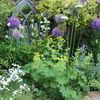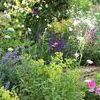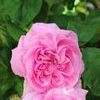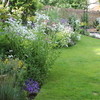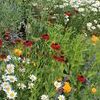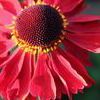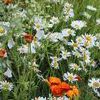Mixed borders of roses, bulbs, herbaceous and annual planting gives an opportunity to really experiment with colour combinations. This year I am creating a ‘warm border’ with a range of plants that include blues, oranges, reds, yellows, whites and purples. Here are some examples:
- Heleniums (variety of cultivars including 'Moorheim Beauty' & 'Double Trouble')
- Nepeta ‘Six Hills Giant’ (Catmint),
- Eschscholzia californica (Californian Poppy)
- Salvia patens
- Calendula officinalis (Marigolds – flowers are edible)
- Leucanthemum vulgare (Ox Eye Daisies)
- Miscanthus sinensis 'Kleine Silberspinne'
- Centaurea cyanus (Cornflowers)
- Begonia 'Glowing Embers'
- Ammi majus
All of these plants work really well together and create a stunning effect.
As for the other borders – the plants have gone wild and are filling every square inch of soil! (Probably because of all the mulch and feed earlier in the year.) I like to allow plants to interweave with one another and create a natural effect. The lime green of the Alchemilla mollis works well off the bright cerise pink of the Salvia microphylla and electrifies the space it occupies. The Alliums look stunning next to the standard variegated holly.
The Ox Eye daisies should only be about two to three feet high, but they have certainly exceeded this and appear to be taking over the garden. I wouldn’t be without them though because they create a swathe of light throughout the garden and flower for several months. The combination of white and green creates a very calming effect in the garden.
It is important to start with a good strong backbone and skeleton of shrubs in the border to act as a backdrop to the herbaceous plants and roses. For example, evergreen shrubs such as variegated Ilex (holly) and Osmanthus, or Pyracantha hold their shape and colour right through the year. Deciduous shrubs add that element of surprise when they start to put on leaf in the Spring, particularly when they have interesting structure, leaves and flowers. Select shrubs that have scent and are good for bees as well as good autumn colour. Intersperse with roses that have a repeat or long flowering period and choose ones that give out wonderful perfume on a hot summer’s day.
The most important thing is to try and create colour all year round and this can be achieved by careful thought and planning. Bulbs are all too often forgotten in this process and tulips, daffodils, hyacinths, anemones, winter aconites, crocuses, snowdrops, bluebells etc., all lift the spirits during Wnter and Spring. Then in late Spring/early Summer the majestic Alliums start to emerge creating a stunning statement in the border. Later in the year, the colour from bulbs continues with Nerines and Autumn crocuses. The list is endless!
If plants are in the wrong place or are becoming thugs in the border, then don’t be afraid to move them or give them away to friends! Just have fun with your colour combinations and see what can happen in just a short time!


